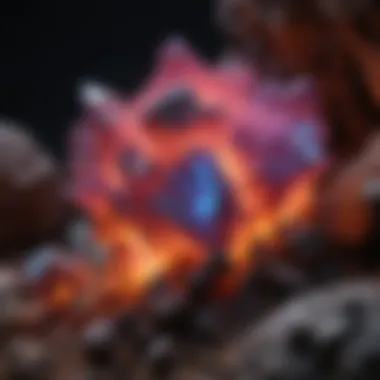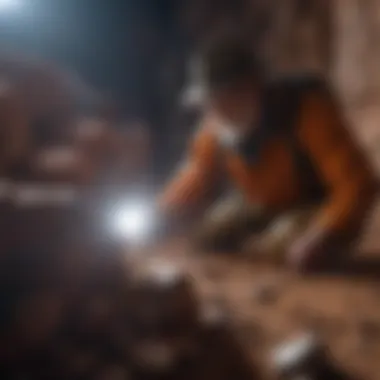Unveiling the Marvels of UV Light for Rockhounding Enthusiasts


Rock and Fossil Identification
Rock and fossil identification is a crucial aspect of the rockhounding experience. Understanding the types of rocks and fossils you may encounter is essential for collectors. With a keen eye, one can distinguish various rocks and fossils based on their unique characteristics. Tools such as magnifying glasses and UV light aid in the identification process by revealing hidden details that are not visible to the naked eye.
Collecting Tips and Techniques
When it comes to collecting rocks and fossils, following best practices is key to preserving their natural state. Choosing prime collecting sites known for their rich geological diversity increases the chances of finding unique specimens. Safety is paramount when extracting specimens, requiring careful techniques to avoid damage and ensure personal well-being. Properly documenting the location and context of each find adds value to the collected specimens.
Preservation and Display
Preserving rocks and fossils is an art in itself. Various techniques, such as consolidating fragile specimens and cleaning minerals, help maintain their integrity. Proper storage is vital to prevent degradation over time, with considerations for temperature and humidity levels. Creativity plays a role in displaying your collection, whether showcasing individual specimens or creating thematic arrangements that highlight their beauty and significance.
Geological Insights
Delving into the geological context of rocks and fossils provides a deeper appreciation for these natural wonders. Understanding the formations and processes that led to their creation offers insight into the Earth's history. Many rocks and fossils hold historical significance, providing clues about past environments and life forms. Notable discoveries in the field of rockhounding have contributed to scientific knowledge and sparked curiosity among collectors and researchers alike.
Introduction to UV Light in Rockhounding
In the realm of rockhounding, an essential element that elevates the exploration experience is the intriguing world of UV light. This article delves into the captivating relationship between UV light and geological specimens. By shedding light on the concept of UV fluorescence, rock and fossil collectors can unlock hidden dimensions within rocks and minerals that are not visible to the naked eye alone. Through the profound understanding of UV light, enthusiasts can delve deeper into the geological composition, unveiling a spectrum of colors and patterns that add a new layer of appreciation to their collections.
Exploring the Concept of UV Fluorescence
What Causes UV Fluorescence in Minerals


When discussing UV fluorescence in minerals, it is crucial to understand the underlying mechanism that triggers this fascinating phenomenon. Certain minerals contain atoms that release visible light when exposed to UV radiation, causing them to fluoresce. This process highlights the unique composition of minerals and allows collectors to differentiate between various specimens easily. The ability of minerals to exhibit UV fluorescence enhances the rockhounding experience by adding a remarkable visual aspect to geological collections.
Different Types of UV Light and Their Effects
The exploration of different types of UV light, including UV-A, UV-B, and UV-C, offers enthusiasts the opportunity to customize their illumination techniques based on the desired effects. UV-A light typically induces a blue-violet fluorescence, UV-B leads to a green response, while UV-C produces a more intense fluorescence in certain minerals. Understanding these distinctions enables collectors to maximize the fluorescence in specific minerals, enhancing the visual appeal of their collections and uncovering hidden features within geological specimens.
Significance of UV Light in Geological Specimens
Highlighting Hidden Features Through Fluorescence
By utilizing UV light, collectors can reveal hidden features within geological specimens that are often overlooked in conventional lighting. The fluorescence effect brought about by UV light illuminates intricate patterns, cracks, and coatings that may go unnoticed under normal conditions. This heightened visibility not only aids in specimen identification but also adds a layer of intrigue to the exploration process, making it a valuable tool for rock and fossil collectors seeking to uncover the full beauty of their finds.
Enhancing the Aesthetics of Collections
UV light not only serves a practical purpose in rockhounding but also enhances the aesthetics of collections. The vibrant fluorescent colors that emerge under UV light transform ordinary rocks and minerals into mesmerizing visual displays. By incorporating UV fluorescence into their collections, enthusiasts can create a unique and visually stunning showcase that captures the essence and beauty of the geological world.
Types of UV Light Sources for Rockhounding
Understanding the different types of UV light sources is crucial for rockhounding enthusiasts seeking to unlock the full potential of UV fluorescence in their mineral and fossil collections. In this section, we will delve into the characteristics and benefits of UV-A, UV-B, and UV-C light sources, shedding light on their unique applications in geological exploration. Each type of UV light offers distinct features that cater to specific needs in rockhounding.
Understanding UV-A, UV-B, and UV- Light
Characteristics and Applications of Each Type
When it comes to UV light sources for rockhounding, UV-A, UV-B, and UV-C light each have their own set of characteristics and applications. UV-A light, with a wavelength range of 315-400nm, is commonly used to detect fluorescent minerals due to its ability to cause minerals to emit light. UV-B light, ranging from 280-315nm, is effective in illustrating patterns and variations in certain minerals. On the other hand, UV-C light, with wavelengths below 280nm, is not commonly used in rockhounding due to its potential risks.


UV-A light is particularly beneficial for rockhounding enthusiasts as it can reveal hidden fluorescent properties in minerals, enhancing the overall aesthetics of collections. Its versatility in illuminating various minerals makes it a popular choice among collectors. UV-B light enhances the visibility of fluorescence patterns in minerals, allowing collectors to discern different minerals based on their unique fluorescent responses. However, UV-C light, while possessing germicidal properties, is not recommended for casual rockhounding due to its potential health hazards.
Exploring the intricate details of each UV light type provides rockhounding enthusiasts with the knowledge needed to select the most suitable light source for their specific geological explorations. By understanding the characteristics and applications of UV-A, UV-B, and UV-C light, enthusiasts can optimize their rockhounding experiences and discover a new dimension in mineral and fossil collections.
Effective Techniques for Using UV Light in Rockhounding
Understanding effective techniques for using UV light in rockhounding is paramount in unlocking the true potential of this tool. By employing the right methods, rock and fossil collectors can enhance their discoveries and gain a deeper insight into geological specimens. These techniques not only aid in identifying fluorescent minerals but also provide a novel perspective on geological artifacts. Effective techniques encompass a range of practices that optimize UV light exposure and aid in distinguishing between fluorescent and non-fluorescent specimens. By implementing these methods thoughtfully, enthusiasts can elevate their rockhounding experiences to new heights.
Optimizing UV Light Exposure
- Best Practices for Illumination: The key to optimizing UV light exposure lies in utilizing the right illumination techniques. By employing appropriate lighting angles and distances, collectors can ensure that fluorescence is maximized without causing overexposure. Best practices for illumination involve using UV light in controlled environments with minimal ambient light to enhance fluorescence effects. This approach allows for the subtle details and colors of minerals to be illuminated, yielding a mesmerizing visual display.
- Avoiding Overexposure Risks: In rockhounding, avoiding overexposure risks is crucial to prevent damage to both specimens and eyesight. By regulating the duration and intensity of UV light exposure, collectors can safeguard against potential hazards. Overexposure risks can lead to the fading of fluorescence over time or even harmful effects on vision. Therefore, adopting proper exposure limits and incorporating adequate breaks during UV light usage is essential to ensure a safe and fulfilling rockhounding experience.
Identifying Fluorescent Minerals
- Common Minerals That Exhibit UV Fluorescence: Recognizing common minerals that exhibit UV fluorescence is essential for collectors to target specific specimens. Minerals such as fluorite, calcite, and willemite are known for their vibrant fluorescence under UV light. Understanding the characteristics of these minerals and how they react to UV illumination can aid in efficient identification during rockhounding expeditions. By focusing on minerals with known fluorescence properties, collectors can increase their chances of discovering visually striking specimens that showcase the wonders of UV light.
- Tips for Distinguishing Fluorescent vs. Non-Fluorescent Specimens: Distinguishing between fluorescent and non-fluorescent specimens requires attention to detail and knowledge of mineral properties. Utilizing UV light to differentiate between these types of minerals involves observing the intensity and color of fluorescence emitted. While fluorescent minerals glow brightly under UV light, non-fluorescent ones remain dull. By employing this visual distinction, collectors can accurately categorize specimens and build a diverse collection showcasing the unique effects of UV fluorescence.
Safety Considerations When Using UV Light for Rockhounding
In the realm of rockhounding, the significance of safety considerations when utilizing UV light cannot be overstated. Rock and fossil collectors diving into the wonders of UV light must prioritize their well-being while exploring geological specimens. By adhering to stringent safety measures, enthusiasts can safeguard themselves from potential harm and enjoy their rockhounding adventures with peace of mind.
Protecting Your Eyes and Skin
UV Radiation Hazards and Precautionary Measures


The paramount importance of protecting one's eyes and skin from UV radiation hazards cannot be emphasized enough in the context of rockhounding. Exposure to UV light, particularly UV-B and UV-C, can pose severe risks to the eyes such as damage to the cornea and retina, while UV-A can penetrate the skin, causing sunburn and potential long-term skin damage. Adhering to precautionary measures such as wearing UV-blocking glasses and applying sunscreen with a high SPF rating is crucial to mitigating these risks effectively. Implementing these measures ensures a safe and enjoyable rockhounding experience, minimizing the potential health impact of UV exposure.
Proper Handling and Storage of UV Light Equipment
Maintenance Tips for Prolonged Usage
When it comes to the maintenance of UV light equipment for rockhounding purposes, careful handling and storage practices play a pivotal role. Proper maintenance not only ensures the longevity and efficiency of the equipment but also enhances safety for the user. Regularly inspecting equipment for any signs of wear and tear, such as frayed cords or cracked casings, and promptly addressing any issues through repair or replacement is essential. Storing UV lamps in protective cases or pouches when not in use can prevent accidental damage and exposure to dust or debris, maintaining their performance over time. By following these maintenance tips diligently, rockhounding enthusiasts can prolong the lifespan of their UV light equipment and continue their exploration of geological wonders seamlessly.
Exploration and Discovery with UV Light
In the realm of rockhounding, the exploration and discovery with UV light unveil a captivating dimension to geological expeditions. Understanding the pivotal role of UV light in rockhounding endeavors is paramount for enthusiasts seeking to enhance their discoveries. By utilizing UV light, rock and fossil collectors can reveal hidden patterns, colors, and details within geological specimens that are not visible under normal lighting conditions. This section delves deep into the significance of exploration and discovery with UV light, shedding light on the intricate world of fluorescent minerals and the visual spectacle they offer to diligent rockhounders.
Enhancing Rockhounding Adventures
Unveiling Hidden Patterns and Colors
Unveiling hidden patterns and colors through UV light is a pivotal aspect of rockhounding adventures. This technique allows collectors to unravel the mesmerizing fluorescent properties of minerals, showcasing intricate patterns and vibrant hues that remain concealed to the naked eye. By revealing these hidden qualities, rock and fossil enthusiasts gain a profound understanding of the mineral composition and structural intricacies, elevating their geological explorations to a new level. The ability to detect subtle variations in fluorescence enhances the aesthetic appreciation and scientific value of collected specimens, making it a sought-after practice in the world of rockhounding.
Creating a Unique Perspective on Geological Artifacts
Another compelling facet of utilizing UV light is creating a unique perspective on geological artifacts. By illuminating specimens with various wavelengths of UV light, collectors can unveil intricate details and anomalies that are often overlooked in traditional lighting. This unique perspective offers a fresh lens through which to view geological treasures, enabling enthusiasts to identify rare characteristics, trace mineral migrations, and appreciate the artistry present in natural formations. Through this distinctive approach, rock and fossil collectors can curate visually stunning collections that serve as testaments to the beauty and complexity of the Earth's geological wonders.
Contribution to Geological Research
Role of UV Light in Geological Studies
The role of UV light in geological studies is indispensable for researchers and scholars alike. UV light facilitates the identification, characterization, and classification of minerals based on their unique fluorescence properties. By leveraging UV light sources, geologists can differentiate between various mineral species, assess the purity of specimens, and conduct detailed analyses of crystal structures. This section explores how UV light serves as a valuable tool in geological research, enabling scientists to unravel the geological history of diverse regions and make significant contributions to the field of earth sciences.
Advancements in Mineral Identification
Advancements in mineral identification due to UV light have revolutionized the way geological specimens are studied and classified. By harnessing the fluorescence emitted by minerals under UV illumination, researchers can pinpoint specific mineral compositions, detect impurities, and distinguish between similar-looking specimens. This technological advancement has paved the way for more accurate mineral identification, extensive mineral databases, and enhanced understanding of geological processes. The integration of UV light in mineral identification represents a quantum leap in geological research, empowering scholars to delve deeper into the intricate world of rocks, minerals, and fossils.







